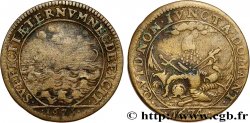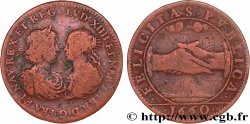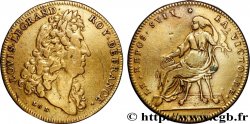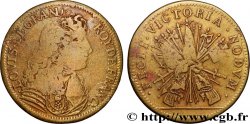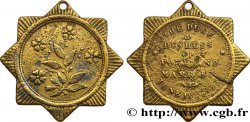fjt_274177 - LOUIS XIV LE GRAND ou LE ROI SOLEIL Établissement des tribunaux appelés “les grands jours” 1666
无库存.
所有在网站上销售的产品 (2013)
价格 : 90.00 €
所有在网站上销售的产品 (2013)
价格 : 90.00 €
种类 Établissement des tribunaux appelés “les grands jours”
日期: 1666
材质 red copper
直径 41 mm
模子方针 12 h.
侧面 lisse
印模 sans poinçon
稀少度 R1
关于品相的说明
Frappe tardive
出版目录中的项代码 :
正面
正面的文字 LUDOVICUS XIIII . REX CHRISTIANISS.
正面的说明书 Buste de Louis XIV à droite, signé I. MAVGER. F.
正面的翻译 (Louis XIV, roi très chrétien).
背面
背面的文字 SALUS PROVINCIARUM ; À L’EXERGUE : REPRESSA POTENTIORUM AUDACIA / MDCLXV ET MDCLXVI.
背面的说明书 Justice, tenant d’une main une épée et une balance, tend sa main droite à une femme, qui représente les provinces affligées. Signé R.
评论
Afin de rétablir l’ordre et la sûreté dans le royaume, des tribunaux furent créés, qu’on appela “les grands jours”. Ils étaient composés d’un président et de plusieurs conseillers du parlement de Paris, une pratique qui rappelle la “délocalisation” d’une affaire telle qu’elle se pratique de nos jours.
Une notice wikipedia http://fr.wikipedia.org/wiki/Grands_jours_d%27Auvergne nous parle de deux d’Auvergne.
Les grands jours d’Auvergne furent des tribunaux exceptionnels du XVIIe siècle, appelés Grands Jours, qui jugèrent en dernier ressort les affaires qui localement ont donné lieu à des décisions contestables ou ont été soustraites à la justice.
Les Grands Jours d'Auvergne eurent lieu à Clermont et au Puy du 28 septembre 1665 au 30 janvier 1666 pour réprimer les abus commis par une partie de la noblesse de la province afin de « tirer les peuples de l'oppression des puissants » selon les mots du procureur général Denis Talon (1628-1698). Cela concernait aussi bien les hobereaux rapaces et brutaux, que les juges locaux corrompus trop accommodants pour les nobles et souvent impitoyables pour les « humbles ». Il y eut près de 12 000 plaintes !
En quatre mois, sur plus de 1 360 affaires, il y eut 692 condamnations prononcées, dont 87 concernaient des nobles. Sur les 347 condamnations à la peine capitale prononcées, seulement 23 furent exécutées, dont beaucoup en effigie :
Claude Pestels de Frayssinet, décapité en 1668 à Clermont;
Charles Durand, baron de Sénégas, décapité à Plaisance sur la place publique.
Jacques Artaud de Saint-Germain, comte d’Apchon (amende et restitution);
Louis de Bourbon, marquis de Malause, (65 000 livres de restitution, 4 000 livres d'amende);
le Comte d'Espinchal, seigneur de Massiac (exécuté en effigie, son château fut confisqué et rasé);
Jacques-Mauléon de Montboissier-Beaufort-Canillac, marquis de Canillac (exécuté en effigie, tous ses biens confisqués, son château rasé).
En contribuant à affirmer l’autorité du roi, « source de toute justice », les Grands Jours ont été l’un des instruments de mise au pas de la noblesse après les troubles de la Fronde.
Jean Mauger, né en 1648, fut élève de Jean Warin. Mauger était médailliste du Roi et travaillait sous le contrôle de l'Académie des Inscriptions et Belles-Lettres. En 1698, il obtînt un appartement au Louvre. Il grava une série très importante de médailles de Louis XIV. Ces médailles historiques furent gravées entre 1697 et 1703.
Une notice wikipedia http://fr.wikipedia.org/wiki/Grands_jours_d%27Auvergne nous parle de deux d’Auvergne.
Les grands jours d’Auvergne furent des tribunaux exceptionnels du XVIIe siècle, appelés Grands Jours, qui jugèrent en dernier ressort les affaires qui localement ont donné lieu à des décisions contestables ou ont été soustraites à la justice.
Les Grands Jours d'Auvergne eurent lieu à Clermont et au Puy du 28 septembre 1665 au 30 janvier 1666 pour réprimer les abus commis par une partie de la noblesse de la province afin de « tirer les peuples de l'oppression des puissants » selon les mots du procureur général Denis Talon (1628-1698). Cela concernait aussi bien les hobereaux rapaces et brutaux, que les juges locaux corrompus trop accommodants pour les nobles et souvent impitoyables pour les « humbles ». Il y eut près de 12 000 plaintes !
En quatre mois, sur plus de 1 360 affaires, il y eut 692 condamnations prononcées, dont 87 concernaient des nobles. Sur les 347 condamnations à la peine capitale prononcées, seulement 23 furent exécutées, dont beaucoup en effigie :
Claude Pestels de Frayssinet, décapité en 1668 à Clermont;
Charles Durand, baron de Sénégas, décapité à Plaisance sur la place publique.
Jacques Artaud de Saint-Germain, comte d’Apchon (amende et restitution);
Louis de Bourbon, marquis de Malause, (65 000 livres de restitution, 4 000 livres d'amende);
le Comte d'Espinchal, seigneur de Massiac (exécuté en effigie, son château fut confisqué et rasé);
Jacques-Mauléon de Montboissier-Beaufort-Canillac, marquis de Canillac (exécuté en effigie, tous ses biens confisqués, son château rasé).
En contribuant à affirmer l’autorité du roi, « source de toute justice », les Grands Jours ont été l’un des instruments de mise au pas de la noblesse après les troubles de la Fronde.
Jean Mauger, né en 1648, fut élève de Jean Warin. Mauger était médailliste du Roi et travaillait sous le contrôle de l'Académie des Inscriptions et Belles-Lettres. En 1698, il obtînt un appartement au Louvre. Il grava une série très importante de médailles de Louis XIV. Ces médailles historiques furent gravées entre 1697 et 1703.








 对产品描述纠错
对产品描述纠错 打印
打印 分享我的选择
分享我的选择 提问
提问 Consign / sell
Consign / sell
 产品介绍
产品介绍